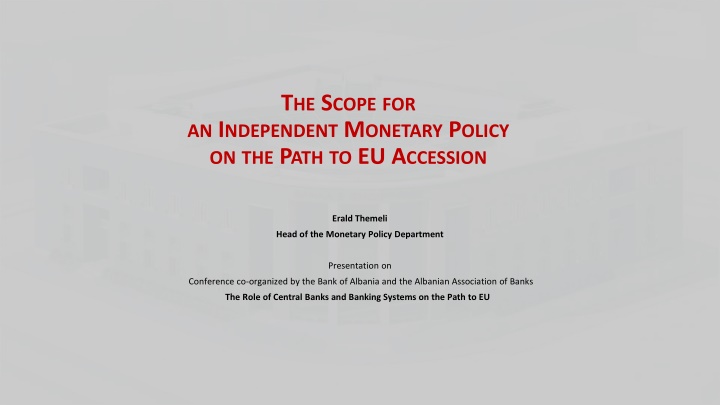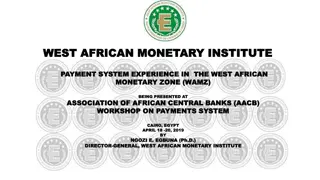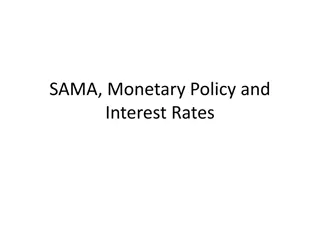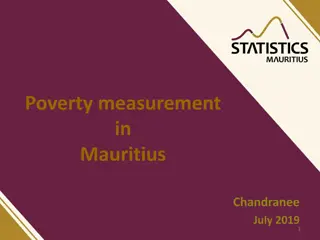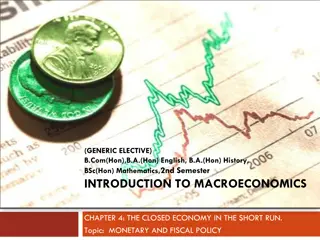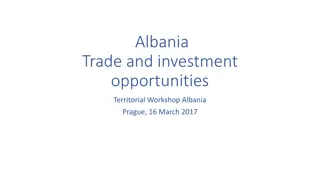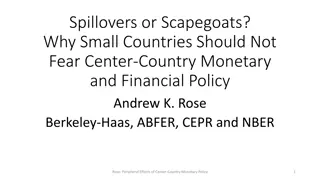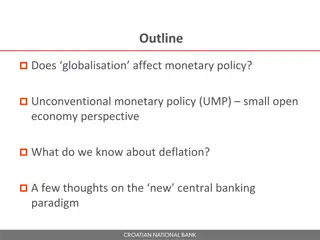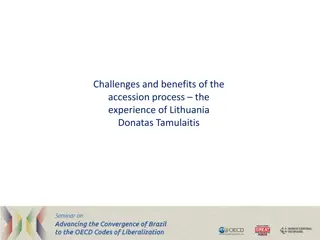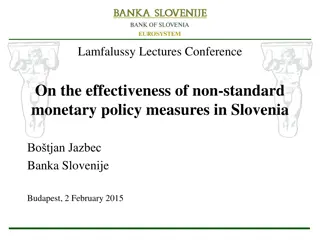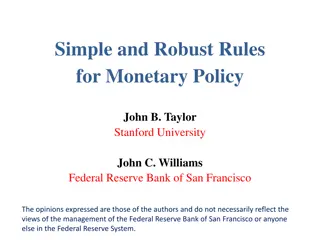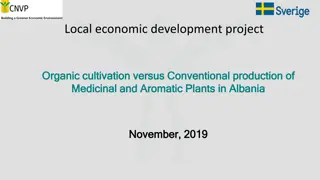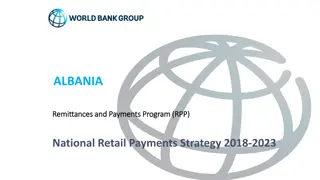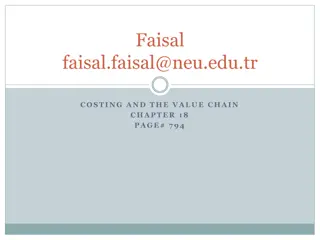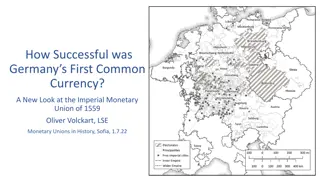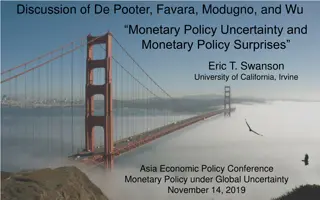Independent Monetary Policy on EU Accession Path: Desirability for Albania
This presentation by Erald Themeli discusses the potential benefits and drawbacks of early Euro adoption for Albania on its path to EU accession. It delves into the theoretical background, criteria for joining a monetary union, cyclical and structural convergence with the Euroarea, and the implications for Albania's monetary policy independence.
Download Presentation

Please find below an Image/Link to download the presentation.
The content on the website is provided AS IS for your information and personal use only. It may not be sold, licensed, or shared on other websites without obtaining consent from the author.If you encounter any issues during the download, it is possible that the publisher has removed the file from their server.
You are allowed to download the files provided on this website for personal or commercial use, subject to the condition that they are used lawfully. All files are the property of their respective owners.
The content on the website is provided AS IS for your information and personal use only. It may not be sold, licensed, or shared on other websites without obtaining consent from the author.
E N D
Presentation Transcript
THE SCOPE FOR AN INDEPENDENT MONETARY POLICY ON THE PATH TO EU ACCESSION Erald Themeli Head of the Monetary Policy Department Presentation on Conference co-organized by the Bank of Albania and the Albanian Association of Banks The Role of Central Banks and Banking Systems on the Path to EU
Motivation EU accession means an irrevocable commitment to an eventual adoption of Euro and access to the Eurozone However, new member states can choose to forego the immediate adoption of the Euro at the moment of access, if such an option is deemed sub-optimal Drawing a balance on the pros & cons of euro adoption / loss of monetary policy independence, is a complex exercise This presentation aims to present a preliminary assessment of the desirability of an early euro adoption for Albania 2
A brief theoretical background The theoretical cost & benefits analysis of a monetary union are broadly grounded on the OCA framework The economic literature establishes three broad criteria / preconditions for joining a monetary union The existence of efficient adjustment & stabilization mechanisms Trade openness Labor and capital mobility Price and wage flexibility Financial integration Fiscal integration & transfers within a monetary union The existence of cyclical convergence The existence of structural convergence 3
Content Cyclical convergence between Albania and Euroarea Structural convergence between Albania and Euroarea A case study on the benefits of independent monetary policy for Albania Conclusions 4
Cyclical convergence Structural convergence Case study Conclusion Assessing Albania s cyclical convergence vis- -vis the Euroarea All three key macroeconomic indicators seem to point to a rather synchronous cyclical behavior of Albanian and Euro area economy in normal times. Source: MPD projections 5
Cyclical convergence Structural convergence Case study Conclusion Assessing Albania s cyclical convergence vis- -vis the Euroarea Three critical episodes of non-synchronous business cycles & diverging key macro indicators vis- - vis the Euro area over a 15 year period. Output Gap Inflation Gap (difference form Target) ST Interest rate across Key Episodes Output gap correlation during normal times (in white) = + 0.33 Output gap correlation during uncertain times (in grey) = - 0.17 Source: MPD projections 6
Cyclical convergence Structural convergence Case study Conclusion Assessing Albania s cyclical convergence vis- -vis the Euroarea Albania has a fair degree of cyclical convergence with the Eurozone, indicating the EA-wide monetary policy stance might be thought of as broadly appropriate However, our inflation and business cycles appear to diverge in times of stress Cyclical convergence breaks down during periods of high economic or financial stress (GFC, Greek Sovereign Debt Crisis, the Conflict in Ukraine) Such Mixed Evidence is evident for the whole region of CESEE A few research papers report minor effects of European factor in the GDP changes of CESEE economies (Afonso & Furceri (2008), Jim nez-Rodriguez et al. (2013), Beck (2020), de Haan et al. (2024) ) Others report significant effect of euro area shocks to the local economies (Petrevski et al. (2015), Deskar-Skrbic et al. (2020)). More selective authors distinguish a higher correlation after the 2004 entry of the 10 new members in EU (Gaechter et al. (2013)). In-house research for Albania shows the Euro area business cycles account for around 10-15% of variation in Albania s business cycle. The rest comes from the global financial cycle (around 40-50%) and idiosyncratic factors (Hoda, 2020). Source: MPD projections 7
Cyclical convergence Structural convergence Case study Conclusion Assessing Albania s structural convergence vis- -vis the Euroarea The Maastricht Criteria Broadly compliant with the inflation differential criteria Recently compliant with both fiscal criterias Source: EC, Instat and BoA calculations Source: EC, Instat and BoA calculations Not that far from interest rate convergence criteria Largely compliant with the ER stability criteria Source: EC, Instat and BoA calculations Source: EC, Instat and BoA calculations 8
Cyclical convergence Structural convergence Case study Conclusion Assessing Albania s structural convergence vis- -vis the Euroarea Incomplete alignment of economic structures Incomplete convergence of income and prices Relatively low capital / capita Source: Eurostat, Instat and BoA calculations Source: Eurostat, Instat and BoA calculations Source: Eurostat, Instat and BoA calculations Slightly divergent economic structures exposes Albania to idiosyncratic shocks. The incomplete convergence of income and prices means an eventual trend appreciation of RER and faster adjustment of relative prices in Albania. The still low ratio of physical capital / capita indicates a higher equilibrium real interest rate. 9
Cyclical convergence Structural convergence Case study Conclusion 1. The Albanian economy at the beginning of the ER appreciation episode slowed down GDP growth The external supply shock raised CPI inflation However, the Lek ER started appreciating by late-2022 and required a tighter MP stance. 10
Cyclical convergence Structural convergence Case study Conclusion 2. The ER appreciation: causes and implications Improved external balances due to higher tourism induced a faster trend appreciation of the RER boosted an already strong aggregate demand and pushed up domestic wages and prices 11
Cyclical convergence Structural convergence Case study Conclusion 3. Policy reaction and results under a flexible ER regime The BoA allowed the ER to appreciate . slowed down the pace of MP normalization without inducing a strong loss in output. thus, maintaining control of inflation 12
Cyclical convergence Structural convergence Case study Conclusion 4. Policy reaction and simulated results under e fixed ER regime A fixed ER would require . a much faster pace of MP normalization while struggling to control of inflation and generating an inferior GDP growth. 13
Cyclical convergence Structural convergence Case study Conclusion 5. Monetary policy under a fixed ER would result in a welfare loss for the economy An outcome of both higher inflation and . a loss in output, would reflect The economy is worse-off in both main metrics, GDP and CPI inflation, in the subsequent years. and higher resulting credit interest rates. the tighter MP needed to control inflation Difference between Simulated Fix Exchange Rate economy and Actual data & Current Baseline for 2025 Forecasts 14
Cyclical convergence Structural convergence Case study Conclusion Concluding remarks Incomplete cyclical and existence of (rather large) structural differences would advocate for a delayed adoption the Euro and the need to maintain an independent monetary policy in Albania as macroeconomic stabilization tool In addition: The BoA has a positive track record in delivering price & monetary stability as well as anchoring inflation expectations An independent monetary policy has served the country well during the past crisis episodes However, we should continuously assess the appropriateness of this policy position The EA remains by far our biggest economic and financial partner and we cannot afford to completely ignore the benefits of a stable exchange rate Structural convergence has accelerated over the last few years Cyclical convergence has strong bias towards endogeneity Source: MPD projections 15
References. Afonso, A., Furceri, D., 2008. EMU enlargement, stabilizations costs and insurance mechanisms. Journal of International Money and Finance. 27, 169 187 Artis, M., Marcellino, M., Proietti, T., 2005. Business cycles in the new EU member countries and their conformity with the euro area. Journal of Business Cycle Measurement and Analysis. 2, 7 41. Beck, K. (2020) Decoupling after the crisis: western and eastern business cycles in the European Union, Eastern European Economics. No. 58 (2020), pp. 68-82 Deskar-S krbic, M., Kotarac, K., Kunovac, D. (2020) The third round of euro area enlargement: are the candidates ready? Journal of International Money and Finance, No. 107(2020). Gaechter, M., Riedl, A., Ritzberger-Gruenwald, D., 2013. Business cycle convergence or decoupling? In: Nowotny, E., Mooslechner, P., Ritzberger-Gruenewald, D. (Eds.), A New Model for Balanced Growth and Convergence. Achieving Economic Sustainability in CESEE Countries. Edward Elgar Publishing, Cheltenham Glos, UK, pp. 147 169. Hoda, B. (2020) The Global Credit and euro area Financial shocks: How Important Are They for Albania, Bank of Albania Working Paper 44 (83) 2020. Jim nez-Rodriguez, R., Morales-Zumaquero, A., gert, B. (2013) Business cycle synchronization between euro area and Central and Eastern European countries, Review of Development Economics No. 17 (2013), pp. 379-395. Source: MPD projections 17
Appendix Explaining the differences in inflation between the actual and simulated policy response under a fixed ER The lower inflation outcome under a flexible ER regime and a stronger Lek is explained by its dampening effect on both imported inflation and the cyclical position of the economy Source: MPD projections 18
Appendix An initially higher GDP growth would be cancelled out by medium term losses Explaining the differences in GDP between the actual and simulated policy response under a fixed ER: A stronger initial output gap due to the positive impact of competitiveness in the 4-6 Quarters, would be cancelled out by losses driven by higher Real Loan Gap in the medium term. Output Gap: (left) Current Baseline & Forecasts differences from Hypothetical Fix ER - less Current Baseline Source: MPD projections 19
